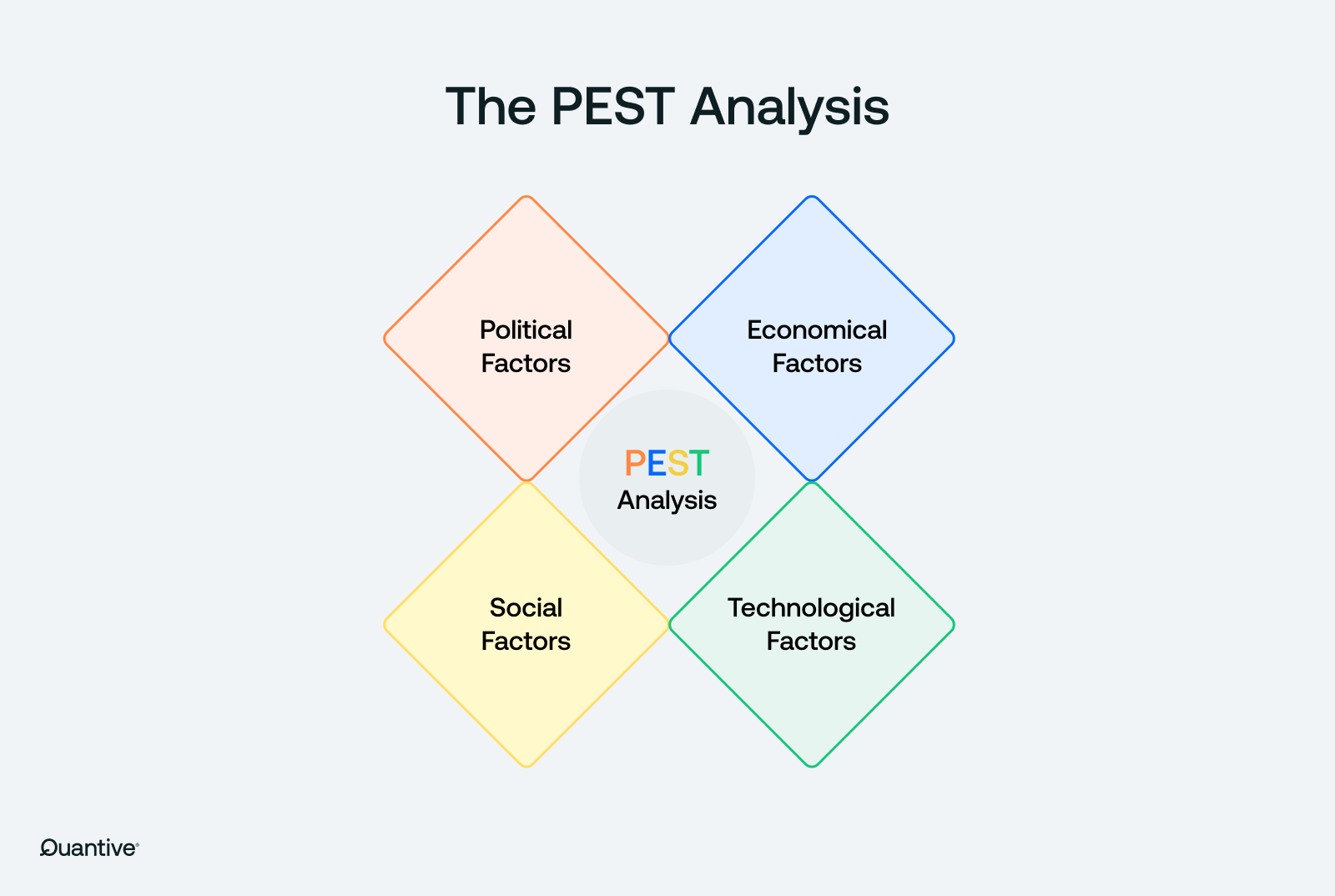Quantive is now part of WorkBoard. Get to know WorkBoard:
Accounting for the external macro-environment is crucial for effective strategic planning and decision-making. Strategic frameworks like the PEST Analysis can help businesses evaluate external factors impacting their operations and long-term success. This article provides a comprehensive overview of PEST Analysis, including its:
- Definition
- Key components
- Use cases
- Example
- Usage steps
- Benefits
What is a PEST analysis?
A PEST Analysis is a strategic framework that helps businesses understand the external macro-environment that can impact their operations. It considers Political, Economic, Social, and Technological factors.
What are the core elements of a PEST Analysis?
- Political factors: Government policies, regulations, and stability
- Economic factors: Economic growth, inflation, interest rates, and currency fluctuations
- Social factors: Demographics, consumer behavior, cultural trends, and social attitudes
- Technological factors: Advancements in technology, innovation, and automation

Note that there is an extended version of the PEST analysis named PESTLE analysis. The PESTLE analysis framework has the same objectives as the PEST analysis but extends the understanding of a business’ environment by also considering Legal (L) and Environmental (E) factors. This is particularly beneficial for businesses operating in sectors under regulatory scrutiny and where the environment plays a major role. For instance, executives in the Oil & Gas sector and the automotive industries should always favor the PESTLE analysis over the PEST analysis.
Who invented the PEST analysis?
Francis J. Aguilar, a Harvard professor in 1967, developed the PEST Analysis. He introduced this strategic framework in his book Scanning the Business Environment. Mr Aguilar's work has significantly influenced modern strategic planning and environmental scanning techniques, making PEST Analysis a foundational tool in business strategy .
When to use a PEST Analysis?
You can use a PEST Analysis in several scenarios to ensure comprehensive external environment evaluation:
- Developing long-term strategies: If your business is planning for the future, PEST Analysis helps anticipate how external factors might influence your operations and strategic direction.
- Evaluating new markets: When entering a new market, a PEST Analysis allows you to analyze the macro-environment to understand potential challenges and opportunities.
- Responding to change: In times of significant external shifts, such as political changes, economic downturns, or technological advancements, PEST Analysis helps identify trends that could create opportunities or threats.
- Launching new products or services: Before introducing new offerings, a PEST Analysis can help you assess how external factors might impact their success and adoption.
- Improving organizational adaptability: If you need to enhance your business’s ability to adapt to external changes, a PEST Analysis provides insights into the external pressures and opportunities, helping you prioritize initiatives and allocate resources effectively.
PEST analysis example: FreshFoods and the FMCG market
Imagine FreshFoods, a company specializing in fast-moving consumer goods (FMCG), is looking to expand its market share and adapt to changing consumer preferences.
Here’s how they used a PEST Analysis to help them navigate the competitive FMCG market and shape its strategies:
Political factors
Through their analysis, FreshFoods found increasing government emphasis on food transparency and safety. They realized that failing to meet these standards could damage their reputation and result in fines. In response, FreshFoods enhanced its product labeling to exceed regulatory requirements, building greater consumer trust and ensuring compliance.
Economic factors
The company’s analysis revealed that consumer spending on premium products decreases during economic downturns. FreshFoods recognized that this trend could lead to reduced sales of their higher-end products. To address this, they diversified their product range to include more affordable options and streamlined their supply chain to manage rising production costs, maintaining competitive pricing without sacrificing quality.
Social factors
The research identified a significant shift towards healthier eating habits among consumers. FreshFoods understood that paying attention to this trend could lose market share to competitors offering more nutritious options. Consequently, they developed new product lines featuring organic and low-sugar options, appealing directly to health-conscious consumers. Additionally, they tailored products to regional dietary preferences to increase local market penetration.
Technological factors
The evaluation highlighted the rapid growth of e-commerce and the importance of online shopping. FreshFoods realized that not adapting to this trend could mean missing out on significant sales channels. In response, they expanded their digital presence by enhancing their e-commerce platform, offering convenient purchase options, and investing in automation technologies for production and logistics to improve efficiency and product quality.
How to use a PEST analysis?
Here’s a step-by-step guide to help you use the PEST Analysis effectively:
Step 1: Identify key factors
Identify the key political, economic, social, and technological factors that could impact your business. Conduct thorough research and gather data from reliable sources to understand each factor's current and potential future states.
Step 2: Analyze their impact
Analyze the potential impact of each PEST factor on your business. Consider both opportunities and threats. This involves assessing how changes in these external factors could influence your strategic goals, operations, and market position.
Step 3: Categorize and prioritize factors
Categorize the identified factors based on their relevance and potential impact on your business. Prioritize the factors that are most likely to significantly affect your operations. This will help you focus your strategic efforts on the most critical areas.
Step 4: Develop strategies
Develop strategies to leverage the opportunities and mitigate the threats identified in your analysis. Create actionable plans that address each PEST factor and align with your business strategy. For example:
- Political: Lobby for favorable regulations, plan for changes in trade policies.
- Economic: Adjust pricing strategies, diversify revenue streams.
- Social: Adapt marketing strategies to changing consumer behaviors, enhance corporate social responsibility efforts.
- Technological: Invest in new technologies, innovate to stay ahead of competitors.
Step 5: Implement Strategies
Execute the developed strategies with clear timelines, responsibilities, and resource allocations. Ensure ongoing communication and support from leadership to drive the changes. Effective implementation is crucial for realizing the benefits of your strategic plans.
What are the benefits of using a PEST analysis?
The PEST Analysis offers significant advantages for businesses that enhance their strategic decision-making. These benefits include:
- Focused macro-environmental insight: Provides a targeted approach to understanding the external factors that directly impact your business, giving you a clearer picture of the broader environment
- Strategic foresight: Helps you anticipate changes in the macro-environment, allowing for proactive strategic planning and preparation
- Informed strategic adaptation: PEST Analysis encourages continuous monitoring of external factors, helping businesses stay agile and responsive to changes in the macro-environment. This adaptability is crucial for maintaining competitiveness in a fast-moving industry sectors.
Keep your business ready for environmental changes with Quantive StrategyAI
Quantive StrategyAI can help you adapt your business to your its environment faster and more confidently. By providing thorough strategic analyses on demand and mapping these to actionable strategic goals, Quantive StrategyAI can help you:
- Identify emerging trends within each PEST category.
- Quantify the potential impact of external factors on your business.
- Develop contingency plans to ensure you're prepared for various scenarios.
Quantive Strategy AI is like having a strategic advisor at your side, helping you navigate the realities of your market and stay ahead of external pressure points.
Quantive empowers modern organizations to turn their ambitions into reality through strategic agility. It's where strategy, teams, and data come together to drive effective decision-making, streamline execution, and maximize performance.
As your company navigates today’s competitive landscape, you need an Always-On Strategy to continuously bridge the gap between current and desired business outcomes. Quantive brings together the technology, expertise, and passion to transform your strategy and playbooks from a static formulation to a feedback-driven engine for growth.
Whether you’re a fast-growing scale-up, a mid-market business looking to conquer, or a large enterprise looking for innovation, Quantive keeps you ahead – every step of the way. For more information, visit www.quantive.com.





